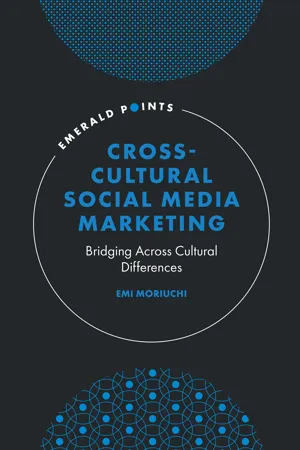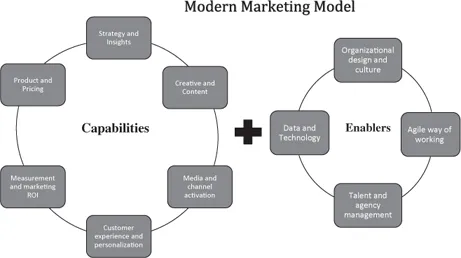![]()
1
AN INTRODUCTION TO SOCIAL MEDIA
Social media is a broad term that is often used loosely to describe an individual’s communication choices. Social media is a form of computer-mediated communication. Within social media, there are several platforms that assists in the communication process. These include social networking sites such as Facebook; microblogs such as Twitter; content communities such as YouTube; community forum such as Reddit, messengers, and virtual world games; and collaborative sites such as Wikipedia (Moriuchi, 2020b). In summary, social media is an umbrella term used to describe the different platforms or sites that people use to interact freely, to share and discuss information with each other about their lives, by using a variety of content including words, memes, and videos (Curtis, 2013).
Despite a long stretch of controversies over privacy, fake new and censorship on social media, the share of consumers around the world using certain online platforms has statistically unchanged from where it was in early 2018 (Perrin & Anderson, 2019). More specifically, for the US adults, the adoption of social media platforms has grown over the past decade but the growth has slowed down recently. Among all the social media platforms, Instagram showed an uptick in users in the past couple of years (2017–2019). Facebook still remains the most widely used social media sites among adults in the USA, UK, and certain Asian countries (e.g., Singapore and Taiwan). YouTube is another online platform that matches Facebook’s reach. The more popular social media platforms for those ages between 18 and 24 are Instagram and Snapchat. As for the newest social media platform, TikTok, the 13–24 years old represent 69% of the app’s user base (Hootsuite, 2018).
Social media has the power to spread information widely and quickly. However, this ability of social media has its pros and cons. For example, there has been a rise in fake news due to misinformation. Consumers around the world receives the wrong information which ultimately causes them to make wrong decisions. On the one hand, since social media is able to spread information widely and has an immediate effect, it has the ability to alleviate social challenges in the real-world (e.g., the fight against the pandemic). For example, the Social Media Toolkit provided by the Centers for Disease Control and Prevention (CDC) leverages the strength of social media and has seen benefits including the timeliness of communication, leveraging audience networks, expanding brand awareness and reach, ability to personalize and reinforce messages, facilitating interactions, and influenced desired behaviors (Lee & Kotler, 2016). For example, the 2009-2010H1N1 and seasonal flu outbreak campaign.
CDC and the U.S. Department of Health and Human Services developed a media campaign that leverages the power of social media tools. They used a variety of features available within social media platforms including buttons, badges, widgets, online videos, podcasts, e-cards, text messaging, social networking sites (e.g., Facebook and Twitter), and virtual worlds.
THE EVOLUTION OF SOCIAL MEDIA
The Internet has changed the history of mass communication, which includes the way people interact and communicate. While some evidence show that the popularity of Facebook is on the older group of Internet users, it is the most popular platform for both consumers and businesses. Social media has evolved over the past decades and have become a dependent tool for businesses to market and promote their products, there has been a debate to whether social media is here to replace older media. McIntyre (2014) used four theories to explain the evolution of social media: displacement theory, functional equivalence, complementary theory, and theory of the niche.
Displacement Theory
Displacement theory explains individual difference, context and motivations for using the Internet affects the type of outcomes people experience from their Internet usage experience (Shen & Williams, 2011). The Internet is not a single undifferentiated medium, rather it is perceived as a system of different parts, with each own nuances and effects. The introduction of the Internet has no doubt made coordination of offline social interactions and facilitate everyday communities with friends and family easier. However, there has been concern that people who spend more hours online would displace time formerly saved for in-person interaction (Nie, 2001). This concern was predicated on the assumption that time is inelastic and a “zero sum phenomenon” (Nie & Hillygus, 2002, p. 2). Since there is only 24 hours a day, individuals tend to prioritize their engagement based on its importance. However, with the introduction of the Internet, time spent online is assumed to displace the activities that are less important.
From a business perspective, the displacement theory is explained as when a new medium comes, it will compete and ultimately replace an older medium (Dutta-Bergman, 2004). Earlier studies have indicated that people who were using the Internet more, were spending less time watching TV and reading physical newspapers (Stempel, Hargrove, & Bernt, 2000). Although there is some truth to the idea that new media may be replacing older media due to the value it provides to the users, some scholars argue that traditional media are not replaced. Traditional media such as TV and phones still exist despite the introduction of emails and online news sources. In that sense, traditional media have not been totally replaced. McIntyre (2014) argued that the reason why traditional media still exists is because modern media are not able to support the displacement theory.
Functional Equivalence
Functional equivalence refers to the dominance of newer media over the older media. This theory explains that newer media dominates because of its ability to better serve a particular function of that medium. “Functional equivalence of news media is defined as providing the same gratifications and gratification opportunities and as providing the same types of content” (Van der Wurff, 2011, p. 140). In general, functional equivalence means that both the traditional media and newer media serve the same purpose but the newer media is able to function better. McIntyre (2014) further asserted that “functional equivalence is based on competition” (p. 10). When a newer media is able to function better, it ultimately means less time is spent on delivering a “message” and is more cost-efficient. For example, a commercial on TV serves the same purpose as an ad on Facebook. However, the cost for a TV spot is more expensive and the frequency is less than what an ad on Facebook could provide. The perceived functional and economical value is higher for the newer media than for the traditional media.
Complementary Theory
Complementary theory refers to the supporting role of newer media for traditional media. Earlier studies found that newer media complement rather than compete with traditional media such as newspapers and radio news. Interestingly, in a recent Nielsen Report (2020), they found that radio consumption rises amid growing concerns about the spread of the coronavirus (COVID-19). In that same report, they found that local TV in times of crisis, radio and on-air personalities present a connection to the real-world that listeners gravitate toward and trust (Nielsen, 2020). Furthermore, when a country has many older generation consumers than newer generation, traditional media is still a comfort media for them.
Theory of the Niche
A niche refers to a specialized area of interest. In the context of a market, a niche refers to a specialized but profitable segment of the market. The role of a niche medium is to complete an existing medium. However, McIntyre (2014) asserted that this relationship between a niche medium and an existing medium does not mean the relationship is without competition. According to Ramirez, Dimmick, Feaster, and Lin (2008), “the theory of niche explains how media compete and coexist in limited resource environments” (p. 530). The interesting aspect of niche medium is that they compete among each other for the audiences’ attention but they do not directly compete to replace each other as do media that follow the displacement or functional equivalence. An example there was an announcement from Pepsi when they forgo their Super Bowl commercials in favor of its Refresh Project to smaller efforts. This smaller effort was in reference to Tabasco’s decision to use social media to experiment a change to their Mardi Gras brand from crazy to more family friendly. This integrated marketing effort is to drive consumers to online destination to where conversations are built to deliver long-term brand results (Martin, 2010).
When planning for an integrated or an extended social media marketing plan, there is a list of questions that needs to be addressed.
These include:
What is the purpose of this social media marketing plan?
Who are we speaking to? Who are your target audience?
Where do these people “live”? In other words, where does most of the communication take place for your target audience?
What kind of content do you need to start a conversation with your target audience?
How do you extend this conversation from traditional media to social media?
How do you get access to people’s social network? According to Pew Research, people trust other people, more than they do with advertising. That trust relies heavily in the content that you share and how authentic and transparent you are.
MODERN MARKETING APPROACH
What is modern marketing? “Modern marketing is the ability to harness the full capabilities of the business to provide the best experience for the customer and thereby drive growth” (Armstrong, Esber, Heller, & Timelin, 2020, para. 2). To understand how marketing has to modernize, there are factors that constitute a model for modern marketing (see Fig. 1.1). These factors are divided into two groups: capabilities and enablers. Capabilities refers to the type of capabilities needed to deliver marketing work (see Fig. 1.2), whereas enablers are defined as the “how to” in leveraging talents inside and outside the organization to deliver the marketing work (see Fig. 1.3). According to McKinsey and Co (2020), capability may not fall directly under the marketing organization, it is dependent on the organizational structure. The definition of modern marketing may differ depending on whether it is consumer-packaged goods and in the business-to-business (B2B) sector. Regardless of the industry, modern marketing techniques are to leverage data from all consumer interactions to creatively deliver as much as one-to-one marketing as possible. This modern marketing model is aligned with the inbound methodology while understanding the consumer behavioral changes.
Source...

